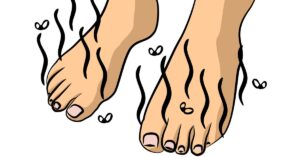Why does toenail fungus smell like cheese? Toenail odors are a common concern and often raise questions about hygiene and health. Many people notice a smell resembling cheese and wonder why it occurs. This odor can be embarrassing and may signal underlying conditions. Understanding its cause can help prevent discomfort and future nail issues.
Cheesy smell and toenail fungus
Toenails can smell like cheese due to bacteria breaking down sweat and dead skin. These bacteria produce sulfur compounds that create a cheesy odor. When toes are confined in tight shoes, moisture builds up and fuels bacterial growth. Poor hygiene or infrequent sock changes can worsen the smell.
Toenail fungus may intensify this odor by causing further buildup of debris under the nail. Fungal infections thrive in warm and damp environments, just like bacteria. As the fungus progresses, it thickens the nail and traps moisture. This trapped moisture allows bacteria to multiply, increasing the cheesy smell. Treating fungus early helps prevent odor and nail damage.

Avoid cheesy-smelling toenails
Preventing the cheesy smell on toenails starts with keeping feet clean and dry. Wash your feet daily using mild soap and warm water. Make sure to dry them thoroughly, especially between the toes. Moisture encourages bacterial and fungal growth, so drying is essential. Change socks daily, or more often if they become damp during the day. Choose breathable socks made from cotton or moisture-wicking materials to reduce sweat buildup.
Wear shoes that allow proper airflow and avoid tight footwear for long periods. Alternate shoes to let them dry completely between uses. Use antifungal foot powder or spray regularly to help control moisture and bacteria. Trim toenails properly to prevent debris buildup under the nail. If signs of fungus appear, seek treatment quickly to avoid worsening conditions and unpleasant odor. Consistent foot care greatly reduces the chances of toenails smelling like cheese.
What is toenail fungus?
Toenail fungus or onychomycosis usually causes the toenails to smell foul. The unpleasant odor is caused by the organism, tinea unguium. Other symptoms of toenail fungus include discoloration and brittleness of the toenail. This condition is common in people who wear closed shoes for long periods of time. The feet are unable to breathe and become sweaty. This becomes the perfect environment for fungus to grow. The fungus thrives in dark and damp environments. It can be worse when you do not wear socks.
Common Symptoms
While invisible nail fungus may not exhibit visible signs, here are some of the typical symptoms associated with toenail fungus:
- Discoloration
- Brittleness of toenails
- Thickening of toenails
- Nail traumas/injuries
- Smelly toenails
If you’re experiencing any of these symptoms, it’s advisable to schedule a free consultation with our podiatrist in the Seattle office. They can determine whether you have a toenail fungus infection and recommend the best treatment option for you.
Preventing Toenail Fungus
Even after successful treatment, prevention is key:
- Dry your feet thoroughly after bathing or swimming
- Wipe between your toes and allow the shoes to air out
- Wear flip-flops in public showers or pool areas
- Avoid sharing shoes, socks, or towels
- Choose breathable footwear
- Maintain proper nail hygiene and trim nails regularly
- Use post-treatment care as recommended by our foot doctors
By keeping your feet clean and dry and practicing these habits, you can reduce the risk of reinfection

Treatment options for toenail fungus
If you do find yourself with a toenail fungus infection, there are several treatment options recommended by foot doctors. Here are some of the common approaches:
- Topical treatments: Over-the-counter creams can help prevent toenail fungal infections. However, they are not very effective for treating an active infection and have a success rate of less than 10%. These creams are most useful as preventive measures or for mild cases of toenail fungus.
- Oral antifungal medication: Medications are commonly prescribed for more severe cases of toenail fungus. However, they come with potential side effects, including liver toxicity. Routine blood testing to monitor your liver is necessary during the course of treatment, and the average cure rate is only around 60%.
- Laser treatment: The most advanced option for toenail fungus treatment is laser therapy. Laser treatment offers a non-invasive and effective approach to eliminating toenail fungus. Various lasers are available, with differing success rates and FDA approvals. The PinPointe laser treatment, approved by the FDA, is a highly effective option, typically requiring only one session and offering no downtime or pain. It targets the fungus directly, penetrating the toenail and killing the infection at its source.
For toenail fungus treatment, we highly recommend the PinPointe Laser as it boasts the highest cure rate in the market. It has no side effects, you can go about your daily activities right after, and it is a painless procedure.
Schedule a Consultation
If you have any signs of nail fungus, don’t wait. Our nail doctors offer the PinPointe laser treatment, the most effective and safe method for curing nail fungus. Call us today at (800) 672-0625 or visit our website to schedule a free consultation at a location near you.





